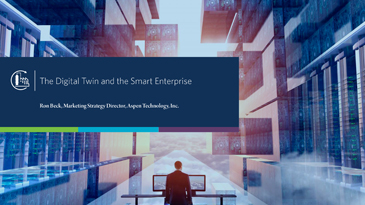My two grandchildren are twins. I can tell you a few things about them. They are definitely not identical. They see the world in different ways. They are pretty insightful. And their insights are different and complementary.
So what would I see if I looked at them digitally? Well, if I looked at a genetic map, they would probably be pretty close to identical. But if I started to look at a medical profile, one has allergies and one doesn’t, one is bigger than the other. And a mental profile? Well, here’s where they diverge in their personalities and thought processes.
What is the correct “digital twin,” or digital view, to use? I think we would all agree it needs to be a combination of these views, and others, to profile each person, to get insight into their wellness and to predict their future.
So what is a digital twin for a process industry asset? What is AspenTech’s definition of digital twins? And where do we believe digital twins are going in the future?
A Digital Twin Is Really Multiple Views of the Asset, Business Processes and People
Just like my oversimplified example of my twin grandchildren makes clear, the digital twin of a process, asset and operation must be a combination of multiple digital views and models. These can be looked at separately or together to gain insight, to optimize, to improve, to predict performance of the asset and to give a true picture of how a “connected worker” can achieve the best possible performance.
Process industry assets are complex. There are many ways to look at them — and, in fact, many ways you must look at them — to first and foremost ensure they are safe, but then to ensure they are performing the desired outcome (a basket of products) in the most sustainable, high-quality, predictable, repeatable and profitable manner possible.
A few months ago I had an interesting conversation over lunch with LNS Research’s Joe Perino. He was digging deeply into how different organizations were defining digital twin. He concluded, exactly as we have at AspenTech, that there is no one digital twin of an asset or operation. There is a spectrum of them.
In fact, Joe had performed an analysis of one mid-size refinery in the U.S. Midwest, and he had concluded that it would take several thousand individual “digital twin models” to fully describe everything of importance about that refinery. (Clearly, that number of digital twins would not be built. The point is there may be a different answer, depending on that asset’s business, sustainability and margin challenges).
As shown in this graphic, digital twins are an evolving digital profile of the historical, current and future behavior of a physical object or process that helps optimize business performance.
They are based on models and real-time data across multiple different dimensions, creating an evolving profile of the object or process in the digital world. This can provide important insights on system performance, leading to actions in the physical world, such as a changes in process design and operation, as well as safety and maintenance improvements.
Here are some examples of companies that have used digital twins to quickly create real business value:
-
A U.S. refiner is deploying a machine learning-based digital twin (Aspen Mtell®) to predict future equipment failure, prevent and plan maintenance, and optimize uptime and yield.
-
ADNOC, at the Shah gas field, has deployed a digital twin encompassing process, energy, utility and hydrocarbon accounting to provide immediate and asset-wide visibility into sustainability metrics (energy use, water use and hydrocarbon losses) to improve overall sustainability.
-
BPCL has created a digital twin, pairing an engineering online model with an APC model, to improve sulfur recovery performance, reducing SOX emissions 95%.
-
Husky Oil has created a multi-asset, network wide, planning digital twin, to evaluate multi-site refining and distribution strategies, creating tens of millions of dollars in improved operating efficiency per planning cycle.
As you can see, there are many possibilities, and they span many operating areas.
Where Is the Future?
Today, many AspenTech customers are getting fantastic business value from digital twins that range from focus on one unit (in the BPCL example above) to a complex set of assets (the ADNOC and Husky examples). The way to start depends on where your organization has the most current business pain, or where you have identified the best area to capture short-term value.
These companies, and many more (we had over 15 different customers present case studies of digital twin implementations at our OPTIMIZE global conference last May), have already gotten a jump on this exciting area. They are using today’s technology to tie models to connected data from assets, to predict and improve asset performance and business process decisions.
Meanwhile, AspenTech is embedding AI across our portfolio of modeling technologies that enable these different areas of digital twin solutions depicted in the wheel graphic above. Thus, the leading companies who are already deploying digital twins with our technology will get a future-proofed pathway into “supercharging” those digital twins with embedded AI.
Furthermore, you will be hearing more from us in coming months about how we will be using hybrid models to provide coordination and synchronization between these different purpose-built models, to achieve closed loop and integrated digital twin views to solve even more challenging business optimization opportunities.
In the coming weeks, our series of ongoing digital twin blogs will cover a number of the topics evoked by the spectrum of possible digital twins, focusing on how they can help solve some of the specific business challenges you’re facing.
If you’d like to learn more about this technology and the opportunities it can create, please read our recent white paper The Digital Twin and the Smart Enterprise.



Leave A Comment